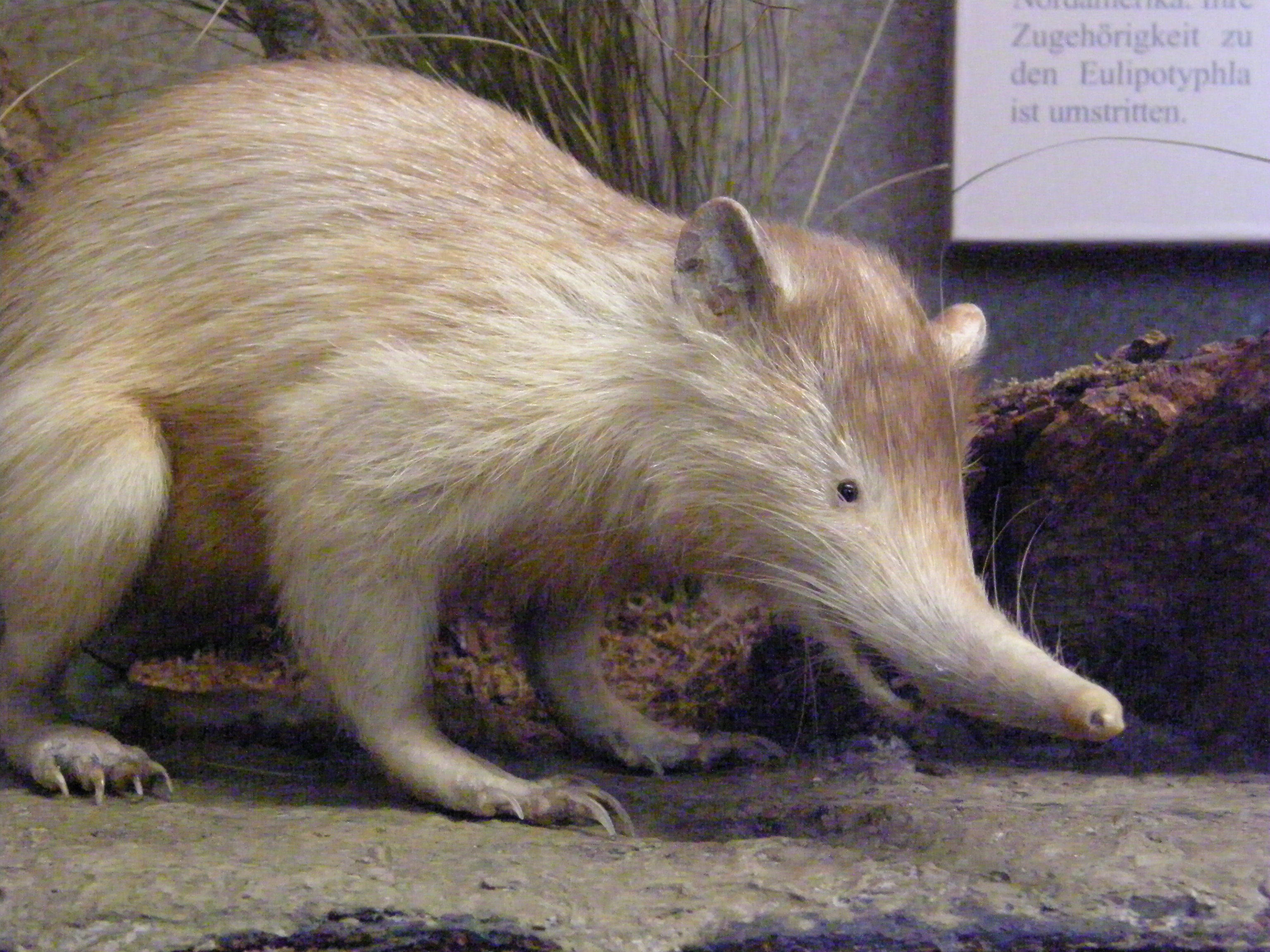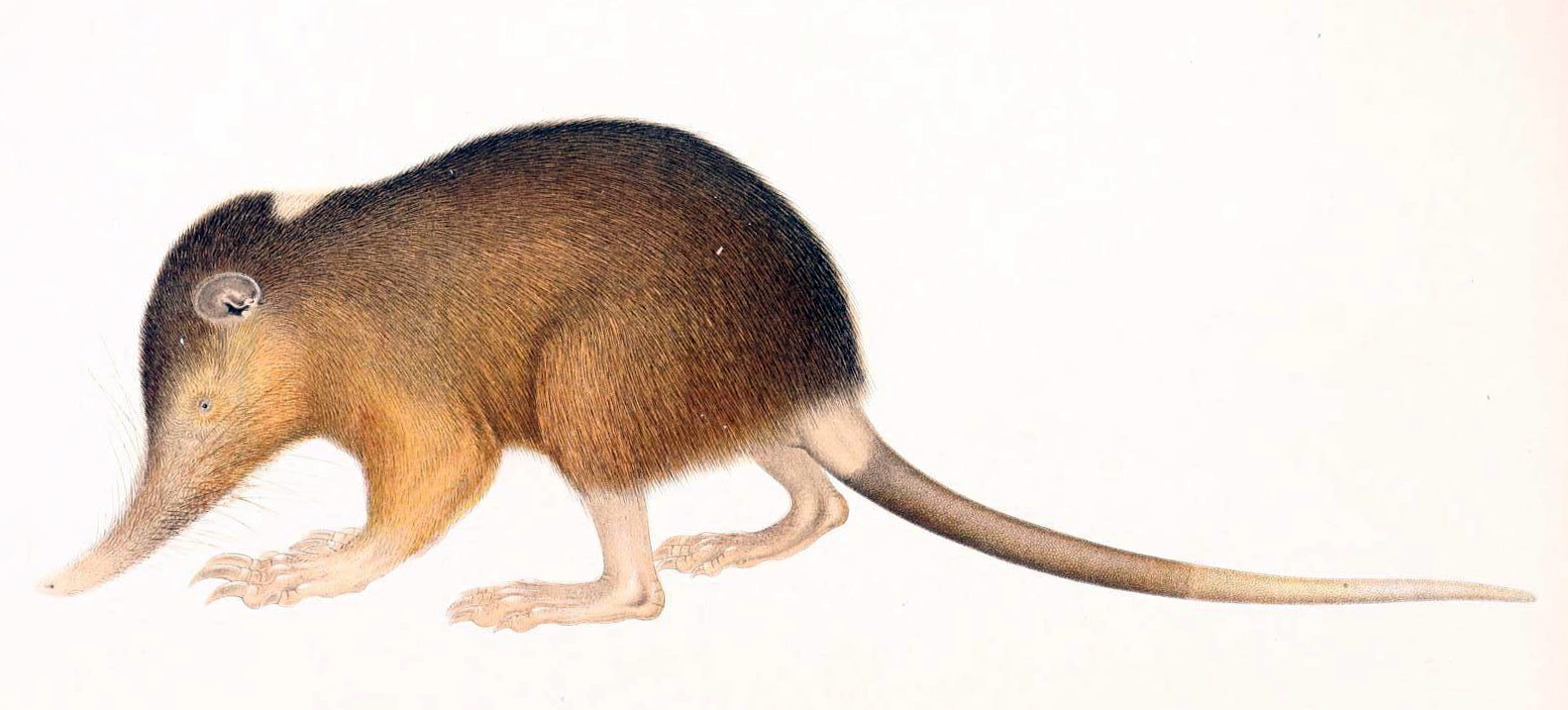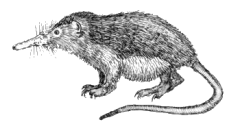|
Solenodontidae
Solenodons (from el, τέλειος , 'channel' or 'pipe' and el, ὀδούς , 'tooth') are venomous, nocturnal, burrowing, insectivorous mammals belonging to the family Solenodontidae . The two living solenodon species are the Cuban solenodon (''Atopogale cubana''), and the Hispaniolan solenodon (''Solenodon paradoxus''). Threats to both species include habitat destruction and predation by non-native cats, dogs, and mongooses, introduced by humans to the solenodons' home islands to control snakes and rodents. The Hispaniolan solenodon covers a wide range of habitats on the island of Hispaniola from lowland dry forest to highland pine forest. Two other described species became extinct during the Quaternary. Oligocene North American genera, such as '' Apternodus'', have been suggested as relatives of ''Solenodon'', but the origins of the animal remain obscure. Two genera, '' Atopogale'' and ''Solenodon'', are known, each with one extant species. Other genera have been erec ... [...More Info...] [...Related Items...] OR: [Wikipedia] [Google] [Baidu] |
Hispaniolan Solenodon
The Hispaniolan solenodon (''Solenodon paradoxus'') is a small, furry, shrew-like mammal endemic to the Caribbean island of Hispaniola (in the Dominican Republic and Haiti). Like other solenodons, it is a venomous, insect-eating animal that lives in burrows and is active at night. It is an elusive animal and was only first described in 1833; its numbers are stable in protected forests but it remains the focus of conservation efforts. Its smaller sister species of the same genus, Marcano's solenodon (''S. marconoi'') became extinct after European colonization. The Hispaniolan solenodon and the rat-like Hispaniolan hutia live in the same habitats and are the only surviving mammals native to the island. Discovery In 1833 the Russian Academy of Sciences received a new specimen from Haiti. Puzzled by the animal, curator Johann Friedrich von Brandt named it ''Solenodon paradoxus''. (''Solenodon'' means "grooved teeth".) No more information was known other than a relation to the Cuban ... [...More Info...] [...Related Items...] OR: [Wikipedia] [Google] [Baidu] |
Solenodon Cubanus Zoothèque MNHN
Solenodons (from el, τέλειος , 'channel' or 'pipe' and el, ὀδούς , 'tooth') are venomous, nocturnal, burrowing, insectivorous mammals belonging to the family Solenodontidae . The two living solenodon species are the Cuban solenodon (''Atopogale cubana''), and the Hispaniolan solenodon (''Solenodon paradoxus''). Threats to both species include habitat destruction and predation by non-native cats, dogs, and mongooses, introduced by humans to the solenodons' home islands to control snakes and rodents. The Hispaniolan solenodon covers a wide range of habitats on the island of Hispaniola from lowland dry forest to highland pine forest. Two other described species became extinct during the Quaternary. Oligocene North American genera, such as '' Apternodus'', have been suggested as relatives of ''Solenodon'', but the origins of the animal remain obscure. Two genera, '' Atopogale'' and ''Solenodon'', are known, each with one extant species. Other genera have been ere ... [...More Info...] [...Related Items...] OR: [Wikipedia] [Google] [Baidu] |
Solenodon (genus)
''Solenodon'' is a genus of small, shrew-like mammals native to the Caribbean. It is one of two genera in the solenodon family, Solenodontidae. The genus ''Solenodon'' includes three species, only one of which is still living—the Hispaniolan solenodon (''Solenodon paradoxus''). This classification follows the American Society of Mammalogists The American Society of Mammalogists (ASM) was founded in 1919. Its primary purpose is to encourage the study of mammals, and professions studying them. There are over 4,500 members of this society, and they are primarily professional scientists .... Species References Extant Pleistocene first appearances Taxa named by Johann Friedrich von Brandt Mammal genera with one living species Mammals of the Caribbean Mammal genera {{eulipotyphla-stub ... [...More Info...] [...Related Items...] OR: [Wikipedia] [Google] [Baidu] |
Soricomorphs Of The Caribbean
The Caribbean region is home to two unique families of the mammalian order Eulipotyphla (incorporating the now defunct order Soricomorpha), which also includes the hedgehogs, gymnures shrews, moles and desmans. Only one Caribbean family, that of the solenodons, is still extant; the other, Nesophontidae, became extinct within the last few centuries. For the purposes of this article, the "Caribbean" includes all islands in the Caribbean Sea (except for small islets close to the mainland) and the Bahamas, Turks and Caicos Islands, and Barbados, which are not in the Caribbean Sea but biogeographically belong to the same Caribbean bioregion. Overview About fifteen species of Caribbean eulipotyphlans are known to have existed during the Quaternary, but not all ''Nesophontes'' species are universally accepted as valid.Hutterer, 2005, p. 220 However, most of these, including all ''Nesophontes'', are now extinct; the Cuban solenodon is classified as Endangered, while the Hispaniolan soleno ... [...More Info...] [...Related Items...] OR: [Wikipedia] [Google] [Baidu] |
Cuban Solenodon
The Cuban solenodon or ''almiquí'' (''Atopogale cubana'') is a small, furry, shrew-like mammal endemic to mountainous forests on Cuba. It is the only species in the genus ''Atopogale''. An elusive animal, it lives in burrows and is only active at night when it uses its unusual toxic saliva to feed on insects. The solenodons (family Solenodontidae), native to the Caribbean, are one of only a few mammals that are venomous. The Cuban solenodon is endangered and was once considered extinct due to its rarity. It and the Hispaniolan solenodon (''Solenodon paradox'') are the only surviving solenodon species; the others are extinct. Taxonomy Although formerly classified in the genus ''Solenodon'', phylogenetic evidence supports it being in its own genus, ''Atopogale''. Rediscovery Since its discovery in 1861 by the German naturalist Wilhelm Peters, only 36 had ever been caught. By 1970, some thought the Cuban solenodon had become extinct, since no specimens had been found since ... [...More Info...] [...Related Items...] OR: [Wikipedia] [Google] [Baidu] |
Dominican Republic
The Dominican Republic ( ; es, República Dominicana, ) is a country located on the island of Hispaniola in the Greater Antilles archipelago of the Caribbean region. It occupies the eastern five-eighths of the island, which it shares with Haiti, making Hispaniola one of only two Caribbean islands, along with Saint Martin, that is shared by two sovereign states. The Dominican Republic is the second-largest nation in the Antilles by area (after Cuba) at , and third-largest by population, with approximately 10.7 million people (2022 est.), down from 10.8 million in 2020, of whom approximately 3.3 million live in the metropolitan area of Santo Domingo, the capital city. The official language of the country is Spanish. The native Taíno people had inhabited Hispaniola before the arrival of Europeans, dividing it into five chiefdoms. They had constructed an advanced farming and hunting society, and were in the process of becoming an organized civilization. The Taínos also in ... [...More Info...] [...Related Items...] OR: [Wikipedia] [Google] [Baidu] |
Haiti
Haiti (; ht, Ayiti ; French: ), officially the Republic of Haiti (); ) and formerly known as Hayti, is a country located on the island of Hispaniola in the Greater Antilles archipelago of the Caribbean Sea, east of Cuba and Jamaica, and south of The Bahamas and the Turks and Caicos Islands. It occupies the western three-eighths of the island which it shares with the Dominican Republic. To its south-west lies the small Navassa Island, which is claimed by Haiti but is disputed as a United States territory under federal administration."Haiti" ''Encyclopædia Britannica''. Haiti is in size, the third largest country in the Caribbean by area, and has an estimated population of 11.4 million, making it the most populous country in the Caribb ... [...More Info...] [...Related Items...] OR: [Wikipedia] [Google] [Baidu] |
Hispaniola Solenodon
Hispaniola (, also ; es, La Española; Latin and french: Hispaniola; ht, Ispayola; tnq, Ayiti or Quisqueya) is an island in the Caribbean that is part of the Greater Antilles. Hispaniola is the most populous island in the West Indies, and the region's second largest in area, after the island of Cuba. The island is divided into two separate nations: the Spanish-speaking Dominican Republic (48,445 km2, 18,705 sq mi) to the east and the French/Haitian Creole-speaking Haiti (27,750 km2, 10,710 sq mi) to the west. The only other divided island in the Caribbean is Saint Martin, which is shared between France ( Saint Martin) and the Netherlands (Sint Maarten). Hispaniola is the site of one of the first European settlements in the Americas, La Navidad (1492–1493), as well as the first proper town, La Isabela (1493–1500), and the first permanent settlement, the current capital of the Dominican Republic, Santo Domingo (est. 1498). These settlements were founded succes ... [...More Info...] [...Related Items...] OR: [Wikipedia] [Google] [Baidu] |
Holocene
The Holocene ( ) is the current geological epoch. It began approximately 11,650 cal years Before Present (), after the Last Glacial Period, which concluded with the Holocene glacial retreat. The Holocene and the preceding Pleistocene together form the Quaternary period. The Holocene has been identified with the current warm period, known as MIS 1. It is considered by some to be an interglacial period within the Pleistocene Epoch, called the Flandrian interglacial.Oxford University Press – Why Geography Matters: More Than Ever (book) – "Holocene Humanity" section https://books.google.com/books?id=7P0_sWIcBNsC The Holocene corresponds with the rapid proliferation, growth and impacts of the human species worldwide, including all of its written history, technological revolutions, development of major civilizations, and overall significant transition towards urban living in the present. The human impact on modern-era Earth and its ecosystems may be considered of global si ... [...More Info...] [...Related Items...] OR: [Wikipedia] [Google] [Baidu] |
Nesophontes
''Nesophontes'', sometimes called West Indies shrews, is the sole genus of the extinct, monotypic mammal family Nesophontidae in the order Eulipotyphla. These animals were small insectivores, about 5 to 15 cm long, with a long slender snout and head and a long tail. They were endemic to the Greater Antilles (except Jamaica), in Cuba, Hispaniola (now the Dominican Republic and Haiti), Puerto Rico, the United States Virgin Islands, and the Cayman Islands. Extinction Although reliable estimates are unavailable, these animals are confirmed to have survived the Pleistocene extinction, since remains have been found among those of ''Rattus'' and '' Mus'' species. Some authorities estimate extinction coinciding with the arrival of rats aboard Spanish vessels in the early 16th century (1500). Others, such as Morgan and Woods, claim that some species survived until the early 20th century. A phylogenetic study in 2016, based on DNA extracted from a specimen about 750 years old, suggest ... [...More Info...] [...Related Items...] OR: [Wikipedia] [Google] [Baidu] |
Cretaceous–Paleogene Extinction Event
The Cretaceous–Paleogene (K–Pg) extinction event (also known as the Cretaceous–Tertiary extinction) was a sudden mass extinction of three-quarters of the plant and animal species on Earth, approximately 66 million years ago. With the exception of some ectothermic species such as sea turtles and crocodilians, no tetrapods weighing more than survived. It marked the end of the Cretaceous Period, and with it the Mesozoic era, while heralding the beginning of the Cenozoic era, which continues to this day. In the geologic record, the K–Pg event is marked by a thin layer of sediment called the K–Pg boundary, which can be found throughout the world in marine and terrestrial rocks. The boundary clay shows unusually high levels of the metal iridium, which is more common in asteroids than in the Earth's crust. As originally proposed in 1980 by a team of scientists led by Luis Alvarez and his son Walter, it is now generally thought that the K–Pg extinction was cause ... [...More Info...] [...Related Items...] OR: [Wikipedia] [Google] [Baidu] |






